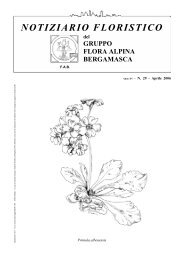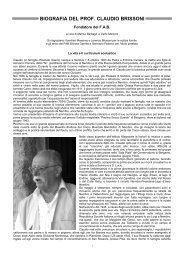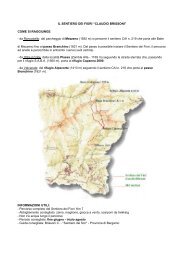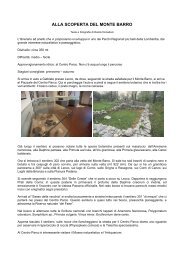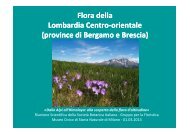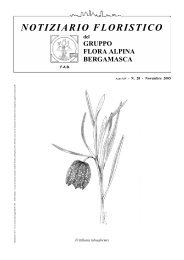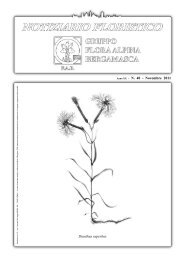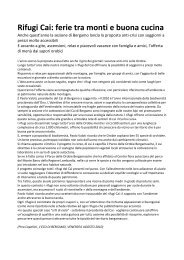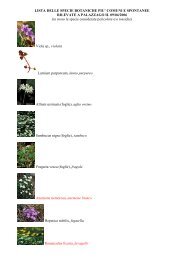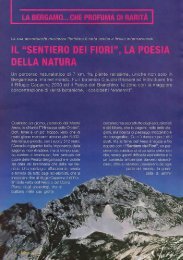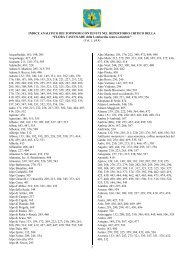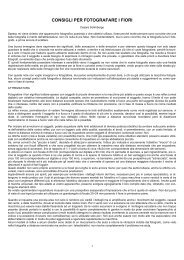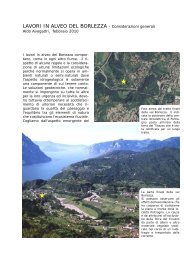IBI 40 Supplemento 1 (2008) - Gruppo Flora Alpina Bergamasca
IBI 40 Supplemento 1 (2008) - Gruppo Flora Alpina Bergamasca
IBI 40 Supplemento 1 (2008) - Gruppo Flora Alpina Bergamasca
You also want an ePaper? Increase the reach of your titles
YUMPU automatically turns print PDFs into web optimized ePapers that Google loves.
Atti Seminario “Studi di Demografia delle Popolazioni”<br />
171<br />
most species-rich habitats in Central Europe are<br />
nutrient-poor grasslands. These habitats have been<br />
strongly fragmented and the remaining sites are<br />
threatened by nutrient enrichment because of cessation<br />
of management, aerial deposition of nitrogen<br />
and nutrient influx from adjacent fertilised land. The<br />
effects of even a single event of nutrient enrichment<br />
can be drastic and very long-lasting. In an alpine<br />
grassland that had been fertilised and limed in the<br />
1930s, we found even 70 years later still significant<br />
effects of the treatments on the pH-value of the soil,<br />
and the composition of the plant and microbial communities<br />
(SPIEGELBERGER et al., 2006).<br />
Nutrient enrichment is often a creeping process and<br />
its effect on plant populations is not always obvious.<br />
Analyses of the structure of plant populations can<br />
indicate hidden problems and demographic studies<br />
are useful to assess the threats to populations and<br />
species. Scorzonera humilis is a long-lived plant of<br />
wet, nutrient-poor meadows that has declined, but<br />
still has a number of large populations in<br />
Luxembourg and Belgium. One might therefore<br />
condider the species to be not particularly threatened<br />
there. However, an analysis of the population structure<br />
revealed that most populations were aged and<br />
consisted of many old but hardly any young plants,<br />
suggesting lack of recruitment. Experimental of<br />
recruitment confirmed this (COLLING et al., 2002).<br />
To get further insight into these processes we studied<br />
the demography of S. humilis at a number of nutrient-poor<br />
and nutrient-rich sites over several years<br />
and analysed the population dynamics using matrix<br />
models. These models indicated that there was little<br />
temporal variation in growth rates and that populations<br />
at nutrient-rich sites would continuously<br />
decline if conditions stayed the same, whereas those<br />
at nutrient-poor sites had growth rates higher than 1.<br />
Mean life expectancy of plants at nutrient-rich sites<br />
was reduced, but was still several decades. This<br />
longevity of plants even at sites where habitat conditions<br />
had deteriorated is the reason for the slow<br />
decline and persistence of the plant. However, stochastic<br />
simulations indicated that populations at<br />
nutrient-rich sites had to be much larger than they<br />
currently are to have a reasonable chance of survival<br />
over the next 100 years (COLLING, MATTHIES, 2006).<br />
A second example concerns Trifolium montanum, a<br />
character species of nutrient-poor calcareous grasslands,<br />
which has strongly declined in Germany. In a<br />
comparative study we found that projected population<br />
growth rates declined with productivity at a site,<br />
indicating negative effects of nutrient enrichment. A<br />
life table response experiment (LTRE) analysis<br />
showed that the survival of non-reproductive individuals<br />
was the life cycle transition most negatively<br />
affected by higher nutrient availability. Further<br />
analyses showed that at sites with higher productivity<br />
the mortality of non-reproductive plants was<br />
increased and the recruitment of young plants<br />
reduced, suggesting that the reduced growth rate<br />
might be due to increased competition by other<br />
species. We tested this hypothesis by carrying out a<br />
mowing experiment that simulated possible management<br />
measures to reduce competition. Mowing in<br />
late summer significantly increased population<br />
growth rates to values above 1. Population models<br />
indicated that mowing every second year would be<br />
sufficient to achieve this. An LTRE analysis showed<br />
that the higher population growth rate under mowing<br />
was due to an increased survival of large individuals<br />
and increased recruitment (SCHLEUNING, 2004).<br />
Populations with a projected growth rate >1 may still<br />
be threatened by stochastic processes, if the size of<br />
populations is too small. We used a modelling<br />
approach to study the relationship between population<br />
size and risk of extinction for T. montanum in<br />
scenarios of different combinations of habitat conditions<br />
and environmental variability. The models<br />
indicated that at very nutrient-poor sites small populations<br />
might have a high chance of survival over<br />
100 years under moderate levels of environmental<br />
stochasticity, whereas at nutrient-poor sites populations<br />
should consist of at least several thousand individuals.<br />
We could relate these requirements to the<br />
known distribution of the size of populations in the<br />
state of Lower Saxony. If all populations grew at very<br />
nutrient-poor sites, the prospects of most populations<br />
would be good, but under the more realistic<br />
assumption that site conditions are only moderately<br />
good (nutrient-poor), only 5% of the existing populations<br />
would be large enough to have a high chance<br />
of survival under moderate levels of environmental<br />
stochasticity (SCHLEUNING, 2004).<br />
The negative effects of habitat fragmentation and<br />
nutrient enrichment may interact. In a study with<br />
Primula veris, we found that plants from small populations<br />
showed reduced plasticity in response to<br />
higher nutrient levels. Small populations would thus<br />
be threatened more by nutrient enrichment than<br />
large populations (KÉRY et al., 2000).<br />
In conclusion, the results of our studies indicate the<br />
following. Habitat fragmentation is a problem for<br />
plants, even if they are growing in suitable and stable<br />
habitats, because small, isolated populations are<br />
threatened by stochastic processes. Short-lived plants<br />
in particular may be negatively affected already in the<br />
short-term through a reduction in reproduction, loss<br />
of genetic variability and reduction of fitness. Due to<br />
the loss of genetic variability, small populations may<br />
be less able to cope with environmental changes in<br />
the long-term. Herbaceous species may consist of<br />
strongly differentiated populations and regionally<br />
adapted genotypes. This has important consequences<br />
for assessing the threat status of species that are<br />
regionally rare, for the planning of reintroduction<br />
programs, and for the interpretation of regional red<br />
data lists.<br />
Plant population biology provides tools that make it<br />
possible to assess the importance of local adaptations,<br />
assess the risk of extinction for local populations<br />
and suggest appropriate management measures<br />
to promote populations of endangered plant species.<br />
Detailed demographic studies using stage-structured<br />
matrix models can reveal critical stages in the life-



